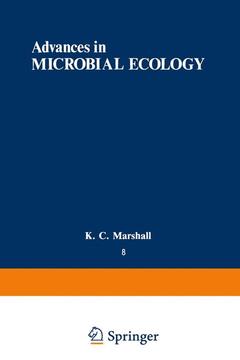Advances in Microbial Ecology, Softcover reprint of the original 1st ed. 1985 Volume 8 Advances in Microbial Ecology Series, Vol. 8
Langue : Anglais
Coordonnateur : Marshall K.

Advances in Microbial Ecology was established by the International Com mittee on Microbial Ecology (ICOME) as a vehicle for the publication of critical reviews selected to reflect current trends in the ever-expanding field of microbial ecology. Most of the chapters found in Advances in Microbial Ecology have been solicited by the Editorial Board. Individuals are encouraged, however, to submit outlines of unsolicited contributions to any member of the Editorial Board for consideration for inclusion in a subsequent volume of Advances. Contributions are expected to be in depth, even provocative, reviews of topical interest relating to the ecology of microorganisms. With the publication of Volume 8 of Advances we welcome to the panel of contributors Martin Alexander, the founding editor of this series, who discusses the range of natural constraints on nitrogen fixation in agri cultural ecosystems. Ecological aspects of cellulose degradation are dis cussed by L. G. Ljungdahl and K. -E. Eriksson, and of heavy metal responses in microorganisms by T. Duxbury. In his chapter, A. Lee con siders the gastrointestinal tract as an ecological system, and comments on the possibility of manipulating this system. The complex interactions among aerobic and anaerobic sulfur-oxidizing bacteria are discussed in terms of natural habitats and chemostat culture by J. G. Kuenen, L. Rob ertson, and H. van Gemerden. Finally, J. A. Robinson presents the advantages and limitations in the use of nonlinear regression analysis in determining microbial kinetic parameters in ecological situations. K. C. Marshall, Editor R. M. Atlas B. B.
1 Microbial Interactions among Aerobic and Anaerobic Sulfur-Oxidizing Bacteria.- 1. Introduction.- 2. The Types of Bacteria.- 2.1. The Colorless Sulfur Bacteria.- 2.2. The Phototrophic Sulfur Bacteria.- 3. Types of Microbial Interaction.- 3.1. Neutralism.- 3.2. Mutualism.- 3.3. Commensalism.- 3.4. Amensalism.- 3.5. Prédation.- 3.6. Competition.- 4. Competition.- 4.1. Competition Involving Chemolithotrophs.- 4.2. Competition Involving Phototrophs.- 4.3. Other Selective Pressures.- 4.4. Competition between Colorless and Phototrophic Sulfur Bacteria.- 5. Other Interactions Involving the Sulfide-Oxidizing Bacteria.- 5.1. Examples among the Chemolithotrophs.- 5.2. Examples among the Phototrophs.- 6. Enrichment Studies.- 6.1. Aerobic Enrichments of Colorless Sulfur Bacteria.- 6.2. Anaerobic Enrichments of Sulfide-Oxidizing Bacteria.- 7. Conclusion.- References.- 2 Determining Microbial Kinetic Parameters Using Nonlinear Regression Analysis: Advantages and Limitations in Microbial Ecology.- 1. Introduction.- 2. Fundamental Definitions.- 2.1. Parameters versus Variables.- 2.2. Linear versus Nonlinear Models.- 3. Use of Linearized Forms of Nonlinear Models.- 3.1. Rationale.- 3.2. Limitations.- 4. Parameter Estimation Strategies.- 4.1. The Function to Be Minimized.- 4.2. Least Squares Estimation.- 4.3. Methods of Minimizing Equation (6) for Nonlinear Models.- 4.4. Weighted Least Squares (WLS) Analysis.- 4.5. Robust Regression.- 4.6. Alternative Objective Functions for the Estimation of Microbial Parameters.- 4.7. Jackknife Estimation.- 4.8. Bootstrapping.- 5. Residuals Analysis.- 5.1. Influence of Correlated Measurement Errors on Parameters Estimated via Least Squares Analysis.- 5.2. Number of Data Points Required for Detection of Correlated Errors.- 6. Model Discrimination.- 7. Optimal Experimental Design.- 7.1. Optimal Experiments for Model Discrimination.- 7.2. Optimal Experiments for Parameter Estimation.- 7.3. Experiments of Optimal Duration.- 8. Some Models of Interest to Microbial Ecologists.- 8.1. Exponential Models.- 8.2. Michaelis-Menten Model.- 8.3. Other Uptake Models.- 8.4. Growth Models.- 8.5. Models with More Than One Independent Variable.- 9. Concluding Remarks.- References.- 3 Neglected Niches: The Microbial Ecology of the Gastrointestinal Tract 15.- 1. Introduction.- 2. Species Diversity in the Gastrointestinal Tract.- 2.1. Factors Influencing Species Diversity.- 2.2. The Host as a Contributor to and a Beneficiary of the Microbial Ecosystem of the Intestinal Tract.- 3. Colonization Resistance.- 3.1. Competition for Nutrients.- 3.2. Toxic Metabolites.- 3.3. Bacterial Barriers.- 4. Perturbation of the Gut Ecosystem.- 4.1. Consequences of the Vacated Niche.- 4.2. Examples of Natural Perturbation.- 4.3. Experimental Perturbations of the Gut Ecosystem.- 5. Consequences of an Immature Microbiota.- 5.1. The Neonatal Animal.- 5.2. The Infant Bowel.- 5.3. Specific Pathogen Free (SPF) Animals.- 6. Immune Mechanisms.- 7. Adaptation to the Ecosystem: Important Determinants of Microbial Pathogenicity.- 7.1. Adhesion to Intestinal Surfaces.- 7.2. Mucus Colonization.- 7.3. Nutrient Avidity.- 8. Behaviorism in the Intestinal Tract: The Importance of What Organisms Do Rather Than What They Are.- 9. Man versus Mouse: The Relevance of Current Concepts of Intestinal Ecology.- 10. Manipulation of the Intestinal Ecosystem.- 10.1. Replacement or Preseeding of the Premature or Perturbed Gut Ecosystem.- 10.2. Selective Decontamination of the Digestive Tract.- 10.3. Environmental Manipulation of the Gut Ecosystem.- 11. Conclusion.- References.- 4 Ecological Constraints on Nitrogen Fixation in Agricultural Ecosystems.- 1. Introduction.- 2. The Rhizobium Inoculum.- 3. Establishment of Rhizobium.- 4. Survival of in Soil.- 5. Biological Stresses on Rhizobium.- 6. Abiotic Stresses on Rhizobium.- 6.1. Acidity.- 6.2. Desiccation.- 6.3. Temperature.- 6.4. Salinity and Alkalinity.- 6.5. Fungicides.- 7. Limitations on Nitrogen Fixation by Cyanobacteria.- 8. Conclusion.- References.- 5 Ecological Aspects of Heavy Metal Responses in Microorganisms.- 1. Introduction.- 2. Effects of Heavy Metals on Microbial Communities.- 2.1. Abundance.- 2.2. Diversity.- 2.3. Metal Tolerance.- 2.4. Evolution and Gene Transfer.- 3. Effects of Heavy Metals on Microbially Mediated Processes.- 3.1. Carbon Fixation.- 3.2. Methanogenesis.- 3.3. Respiration.- 3.4. Litter Decomposition.- 3.5. Dinitrogen Fixation.- 3.6. Other Nitrogen Transformations.- 4. Effects of Heavy Metals on Various Interactions.- 4.1. Substrate Interactions.- 4.2. Predator-Prey Interactions.- 4.3. Interfacial Interactions.- 4.4. Pathogenic Interactions.- 5. Common Problems.- 5.1. Field-Oriented Studies.- 5.2. Laboratory-Oriented Studies.- 5.3. Problems in General.- 6. Future Prospects.- References.- 6 Ecology of Microbial Cellulose Degradation.- 1. Introduction.- 2. Structure of Cellulose.- 3. Cellulolytic Microorganisms.- 3.1. Properties of Wood-Rotting Fungi.- 3.2. Anaerobic Cellulolytic Fungi.- 3.3. Cellulolytic Enzyme Systems in Fungi.- 3.4. Cellulolytic Bacteria and Their Cellulase Enzyme Systems.- 4. Interaction among Microorganisms in Ecological Systems.- 4.1. Cellulose in Soils.- 4.2. Cellulose Degradation in an Aerobic Environment.- 4.3. Cellulose Degradation in an Anaerobic Environment.- 5. Conclusion.- References.
Date de parution : 03-2012
Ouvrage de 307 p.
15.2x22.9 cm
Disponible chez l'éditeur (délai d'approvisionnement : 15 jours).
Prix indicatif 52,74 €
Ajouter au panierThème d’Advances in Microbial Ecology :
Mots-clés :
ecology; ecosystem; microbial ecology; microorganism; nitrogen; system
© 2024 LAVOISIER S.A.S.



